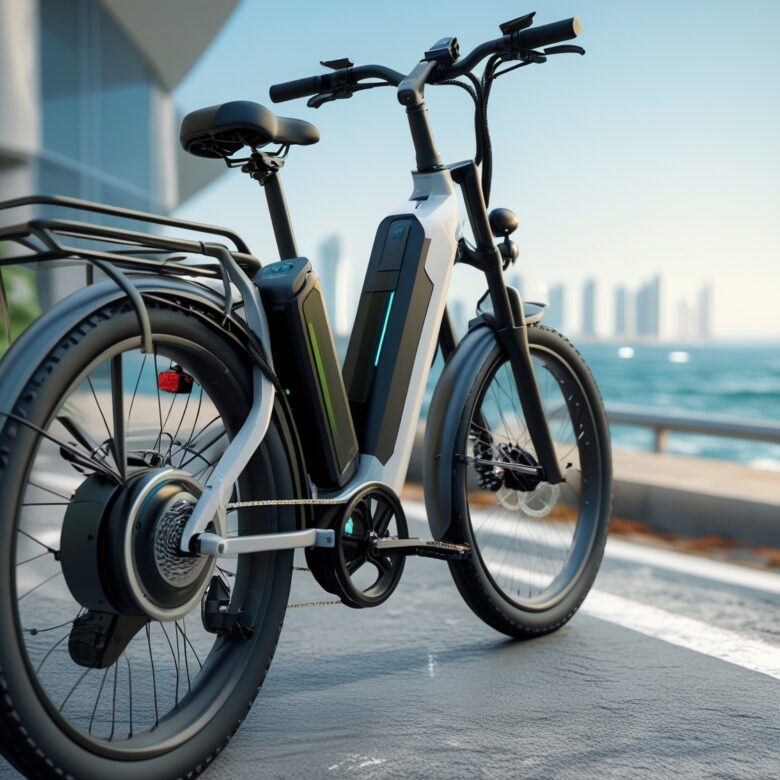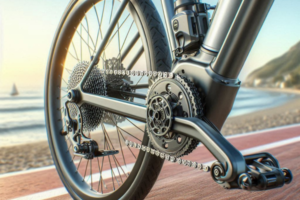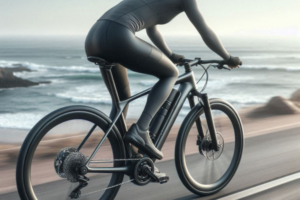🔋 The Secret to Maintaining Speed: Smart Battery Management
Many e-bike riders focus on upgrading motors or adjusting mechanical components to improve speed. But one of the most powerful and often overlooked ways to sustain optimal velocity is through proper battery management. Your e-bike’s battery is more than just a power source—it’s the engine behind your speed consistency, acceleration, and range. If neglected, even the most powerful setup will underperform.
Unlike traditional bicycles, electric bikes rely on steady voltage output to deliver motor efficiency. A poorly maintained battery can cause voltage drops, sudden power loss, and limited torque—resulting in decreased speed and poor ride quality. By implementing good battery practices, you ensure your e-bike performs at its peak throughout every ride.
🌊 Special Considerations in Humid and Coastal Environments
Humidity and salty air pose serious risks to e-bike batteries. Riders near the coast must account for these invisible threats that accelerate corrosion and degrade electrical connections. Moisture can seep into ports and enclosures, while salt in the air can affect battery terminals over time. That’s why battery care isn’t just optional—it’s a necessary part of maintaining speed and preserving performance in these regions.
🛠️ Essential Battery Management Tips to Keep You Fast
- Avoid full charges and full discharges: Keep the battery level between 20% and 80% to extend life and maintain steady voltage.
- Charge at room temperature: Extreme heat or cold during charging can stress lithium cells, leading to performance loss.
- Unplug once fully charged: Even with modern smart chargers, prolonged connection can generate excess heat and shorten lifespan.
- Dry storage is key: Keep your battery indoors, in a ventilated, cool space when not in use—especially in humid climates.
- Use protective covers: A silicone or rubber battery case can help shield against moisture and reduce impact from road vibration.
📊 How Battery Health Affects Speed
Speed is directly tied to how much current your battery can deliver on demand. A well-maintained battery supplies consistent voltage, allowing your motor to deliver smooth acceleration and sustained top speeds. A degraded battery, on the other hand, may sag under pressure—especially during climbs or headwinds—leading to slowdowns even with pedal assistance.
📈 Performance Visual: Battery Power vs. Speed Consistency
| Battery Condition | Speed Performance | Risk of Power Drop |
|---|---|---|
| Well-maintained | High and consistent | Very low |
| Partially degraded | Moderate with fluctuations | Medium |
| Heavily degraded | Low and unstable | High (especially under load) |
💡 Insight: The smoothest rides don’t come from more power—they come from consistent energy delivery. A healthy battery equals steady speed.
🔌 Advanced Charging & Storage Habits That Preserve Speed
Getting the most out of your e-bike’s speed doesn’t require pushing the throttle harder—it requires making smart decisions about how you charge and store your battery. These two routines directly influence your battery’s internal chemistry and long-term performance. Even small missteps in charging or storage can cause voltage inconsistencies, reduce energy capacity, and limit your bike’s ability to sustain higher speeds over time.
⚡ Smart Charging Strategies to Optimize Power Output
Not all charging sessions are equal. While most e-bike riders plug in overnight and forget it, a more intentional approach can dramatically impact your motor’s efficiency and acceleration over the long haul.
- Charge up to 80% for regular use: Lithium-ion batteries perform best and degrade slower when kept in mid-range levels. Avoid charging to 100% daily unless preparing for a long-distance ride.
- Charge in the shade, never in direct sunlight: External heat combined with internal cell heating accelerates chemical breakdown.
- Wait after a ride: Let the battery cool down for 30 minutes before charging. Charging a warm battery adds thermal stress and shortens lifespan.
- Use only certified chargers: Off-brand or incompatible chargers can cause uneven charging or overheating, leading to early degradation or even fire risk.
📦 Long-Term Storage: Protecting Battery Health While Idle
If you won’t be riding for a week or more, how and where you store your battery becomes crucial. Incorrect storage leads to deep discharges, corrosion, and physical stress on battery cells—especially in humid environments where condensation can creep into connectors.
- Store at 50–60% charge: Never leave a battery fully charged or completely drained in storage. Mid-range levels are ideal for cell stability.
- Choose dry, ventilated spaces: Avoid sealed plastic bags, damp garages, or enclosed cabinets where moisture and heat build up.
- Check the charge monthly: Batteries naturally lose charge over time. Top up to 60% if the level drops below 30% during storage.
- Disconnect from the e-bike: Leaving the battery connected may cause slow energy draw from the system, leading to deep discharge.
📊 Charging Frequency vs. Battery Longevity
| Charging Behavior | Battery Lifespan | Speed Efficiency |
|---|---|---|
| Frequent 80% top-ups | Longer (800–1000 cycles) | High and stable |
| Full charge/discharge daily | Shorter (300–500 cycles) | Unstable under load |
| Charging in heat or immediately after use | Very short | Sluggish with voltage dips |
🧠 Visual Tip: Think of Charging Like Eating
You wouldn’t eat three massive meals a day and expect to feel great. Batteries work the same way—overfeeding or starving them causes internal stress. Small, smart “meals” (partial charges) help them stay balanced, energized, and ready to perform.
💡 Pro Tip: Keep a sticky note on your charger with your ideal routine—charge to 80%, unplug when full, cool down first. Consistency is key!
💡 Reflection: A battery thrives on rhythm. Treat it with care today, and it will reward you with speed tomorrow.
⚠️ Common Battery Mistakes That Reduce Your E-Bike’s Speed
Even with a premium motor and a high-capacity battery, simple missteps in daily battery handling can slowly erode your e-bike’s performance. These aren’t just maintenance oversights—they’re speed killers. If you’ve ever noticed your bike feels sluggish or doesn’t hold power like it used to, there’s a good chance one of these common mistakes is to blame.
🛑 Top Missteps Riders Make
- Charging to 100% daily: While it seems like the most logical way to maximize range, keeping your battery at full charge stresses lithium cells, especially when done repeatedly in warm climates.
- Letting the battery drain to 0%: Deep discharges are one of the fastest ways to shorten battery lifespan. Low voltage cut-offs can also result in unexpected power drops mid-ride.
- Charging right after riding: Plugging in while the battery is still warm increases internal heat, accelerating chemical wear inside the cells.
- Leaving the battery connected 24/7: Even when idle, a connected battery slowly drains through background systems, risking deep discharge over time.
- Ignoring signs of damage or swelling: If your battery casing appears bloated or shows corrosion near terminals, continued use becomes unsafe and dramatically reduces energy efficiency.
📊 Table: Mistake vs. Speed Consequences
| Mistake | Immediate Impact | Long-Term Speed Effect |
|---|---|---|
| Charging to 100% daily | Extra heat buildup | Faster voltage sag during rides |
| Letting battery drop to 0% | Power cut-off during hills | Reduced peak current delivery |
| Charging right after use | Thermal stress on cells | Shorter lifespan, lower top speed |
📋 Prevention Checklist
- ☐ Do I wait 30 minutes before charging post-ride?
- ☐ Am I unplugging my charger once it reaches 80–90%?
- ☐ Is my battery stored above freezing and below 85°F (30°C)?
- ☐ Do I inspect for swelling, corrosion, or loose connectors monthly?
- ☐ Am I topping off storage batteries monthly to prevent deep discharge?
🌬️ A Visual Analogy: Battery Abuse is Like Overinflated Tires
Imagine inflating your bike tires to the maximum every single day, riding full force, and never checking for wear. Eventually, the pressure turns to weakness. Your battery’s chemistry reacts the same way—excessive top-ups, heat, and stress make it lose its ability to deliver consistent performance. Balance is everything.
💡 Pro Tip: Keep a simple journal or app to track battery behavior. Over time, you’ll notice trends like faster drainage or weaker climbs that point to deeper battery issues.
💡 Reflection: A battery doesn’t fail overnight—it fades from habit. Smarter habits restore its strength and your speed.
🧰 Weekly Routine and Toolkit to Preserve Battery Speed
Maintaining speed on your e-bike doesn’t just come from riding—it comes from caring. A simple weekly battery care routine can make a huge difference in how your bike performs over time. With just 10–15 minutes each week, you can protect your investment, prevent avoidable degradation, and ensure that your bike remains fast, responsive, and reliable.
📅 Weekly Battery Maintenance Plan
Set aside a short time once a week—preferably the same day each time—to go through this quick yet powerful checklist:
| Task | Why It Matters |
|---|---|
| Wipe battery contacts and housing | Prevents corrosion and ensures good electrical connection |
| Inspect for swelling, leaks, or unusual heat | Catches early warning signs of battery failure |
| Check charge level | Ensures battery isn’t left overcharged or deeply discharged |
| Clean battery vents if applicable | Improves thermal regulation and longevity |
🛠️ Your Essential Battery Toolkit
- 🔧 Microfiber cloth: Ideal for cleaning terminals and battery casing without scratches.
- 🧴 Electrical contact cleaner: Helps remove moisture, dust, and mild corrosion from terminals.
- 🌡️ Digital thermometer: Useful for checking storage areas or monitoring charging temperatures.
- 🗃️ Silica gel packs: Great for absorbing moisture in storage boxes or saddle compartments.
- 📲 Battery monitoring app (if supported): Lets you track battery performance and detect voltage drops in real time.
📋 Weekly Habit Tracker
- ☐ Cleaned battery housing and terminals
- ☐ Checked for swelling or irregular heat
- ☐ Verified storage environment (cool, dry, ventilated)
- ☐ Ensured battery charge stayed between 30–80%
- ☐ Logged charge cycles or performance notes
📦 A Visual Analogy: Your Battery as a Garden
Think of your battery like a garden. You don’t just water it once and expect it to flourish forever—you check on it regularly, trim what’s needed, and respond to its signs. If you ignore it for too long, weeds grow and roots weaken. Likewise, neglecting battery health—even for a few weeks—can slow you down in ways that feel irreversible.
💡 Pro Tip: Place your toolkit and checklist near your charger or bike station so you never forget your weekly ritual. The easier it is to follow, the more likely you’ll keep your battery running at peak performance.
💡 Reflection: Speed is a result—but care is the cause. A little weekly attention creates miles of smooth, confident riding.
💬 Frequently Asked Questions (FAQs) About Battery and Speed
Does battery condition really affect my e-bike’s speed?
Yes—directly. A well-maintained battery supplies consistent voltage to the motor, which helps maintain smooth acceleration and top-end speed. A degraded battery can’t keep up with demand, especially during climbs or windy conditions, causing noticeable slowdowns.
How often should I check my battery for issues?
Ideally, every week. A quick visual inspection for swelling, corrosion, or overheating—alongside checking charge level and cleaning the terminals—can prevent long-term issues and sudden failures.
Is it okay to leave my battery on the charger overnight?
Occasionally? Yes. But as a habit, no. While smart chargers prevent overcharging, leaving your battery plugged in for long periods creates residual heat and slow stress that can reduce its lifespan over time.
Can I use my e-bike in the rain without damaging the battery?
Yes—most e-bikes have water-resistant battery housings. However, after riding in rain or near saltwater, always dry the battery area and check for moisture near ports. Humidity and corrosion are long-term threats if ignored.
How do I know when it’s time to replace the battery?
Signs include reduced range, power inconsistencies, long charge times, or visible wear. If your e-bike starts feeling sluggish even on full charge, it’s time to test voltage levels or consult the manufacturer.
💖 Final Thoughts: Protect the Heart of Your Ride
Your battery is more than a power source—it’s the heart of your electric journey. Every ride, every push of the motor, every smooth climb depends on its health. With just a few intentional habits, you can dramatically extend its performance and keep your speed sharp for years to come.
Battery care is not about complexity—it’s about consistency. A wipe here, a charge check there, a little cooling time after a ride… these are the acts of a rider who respects the road, the machine, and their own experience. In that respect lies the difference between slowing down and soaring forward. 🔋✨
💡 Inspiration: Power doesn’t come from pushing harder. It comes from protecting what already drives you.
🌍 Join the Conversation: What’s Your Battery Ritual?
Do you have a go-to routine to care for your e-bike battery? Have you ever recovered from battery-related issues and improved your ride? Or are you just starting to build your own habits of care and want some guidance?
Share your story:
🔋 What charging method changed your battery life?
🛠️ What mistake did you stop making?
🌧️ How do you protect your battery in tough weather?
Leave a comment and help create a global space of knowledge-sharing and smart riding. Because the more we learn from each other, the farther—and faster—we go. 🚴♀️💬🌟



